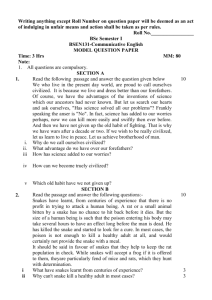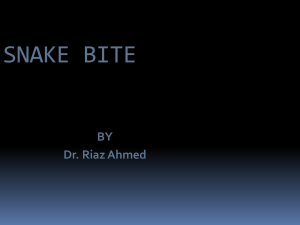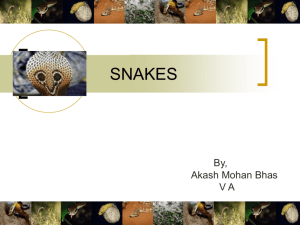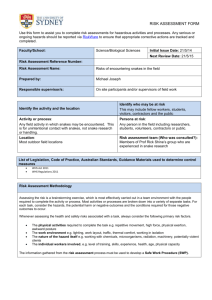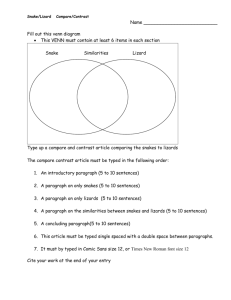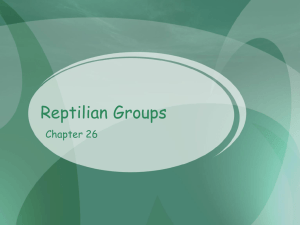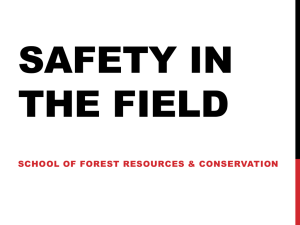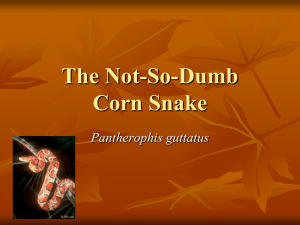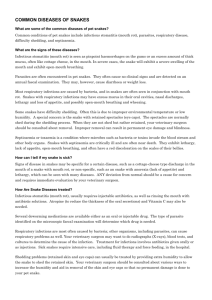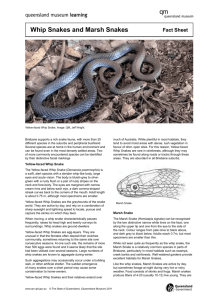Class Amphibia - LBCC e
advertisement
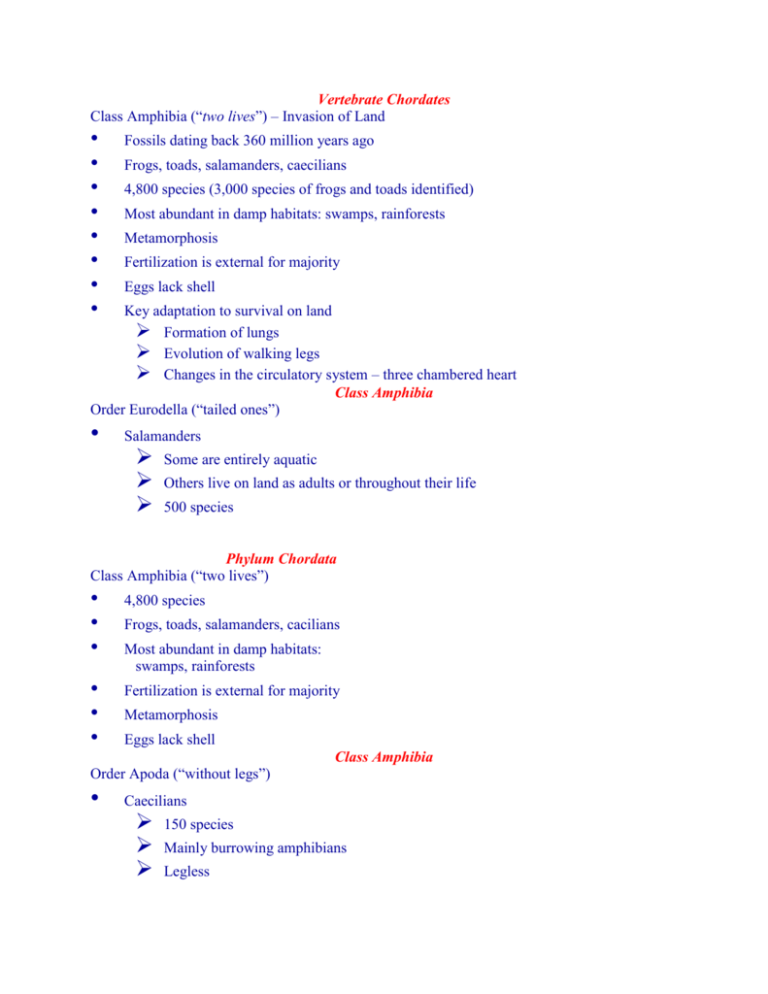
Vertebrate Chordates Class Amphibia (“two lives”) – Invasion of Land • • • • • • • • Fossils dating back 360 million years ago Frogs, toads, salamanders, caecilians 4,800 species (3,000 species of frogs and toads identified) Most abundant in damp habitats: swamps, rainforests Metamorphosis Fertilization is external for majority Eggs lack shell Key adaptation to survival on land Formation of lungs Evolution of walking legs Changes in the circulatory system – three chambered heart Class Amphibia Order Eurodella (“tailed ones”) • Salamanders Some are entirely aquatic Others live on land as adults or throughout their life 500 species Phylum Chordata Class Amphibia (“two lives”) • • • • • • 4,800 species Frogs, toads, salamanders, cacilians Most abundant in damp habitats: swamps, rainforests Fertilization is external for majority Metamorphosis Eggs lack shell Class Amphibia Order Apoda (“without legs”) • Caecilians 150 species Mainly burrowing amphibians Legless Nearly blind Tropical habitat Order Anura (“tailless ones”) Frogs and Toads • • 4,200 species Lacks tail as an adult “Dual life” of a frog (Rana temporaria) The origin of tetrapods Skeleton of Acanthostega, a Devonian tetrapod fish Amphibian orders: Newt (left), frog (right) A hypothetical phylogeny of amniotes Taxonomic classes of amniotes Vertebrate Chordates Class Reptilia • • Examples: lizards, snakes, crocodiles, etc. Special adaptations of reptiles Dry skin covered with scales that efficiently retard water Have amniotic eggs Yolk, albumen = food supply Amnion Leathery (hard) shell Internal fertilization Three-chambered heart Ectotherms Amniotic egg anatomy A hatching reptile Snakes • • • • 24,000 living species Snakes are different from lizards primarily based on: Feeding mechanisms Most snakes feed on larger animals, usually several times their own diameter Sense organs • Have a sensitive forked tongue, which is an organ of touch and smell Sense of smell is well-developed Lack movable eyelids. Eyes are covered by transparent layer. Majority have good vision Can’t hear; lack middle and inner ear. Can detect low frequency ground vibration through skull bone. Patterns of locomotion No legs present Snake Evolution • Evolved from lizards Most likely evolved from burrowing groups of lizards A few primitive snakes also burrow (worm snakes) Python and boas still have rudiments of hind legs that are used for courtship Ball python Snakes – Hunting and Feeding Two methods to immobilize their prey • • Constrictors Boas, pythons, king snakes, etc. Poisonous How do snakes do this? Snake Venom Venomous snake species make up only one fifth of all snakes. Three most important types of toxins found in snake venom: • • Neurotoxins - Affect the nervous system by seizing up the nerve centers, causing breathing to cease Cardiotoxins - Deteriorate the muscles of the heart, causing it to stop often beating • • • • Hemotoxins - Cause the blood vessels to rupture, resulting in widespread internal bleeding Some venom may also include agglutinins, which make the blood clot, or anticoagulants, which make the blood thin. Most snake venom makes use of several of these compounds for a deadly combined effect. Rattlesnakes Only poisonous snake native to California Poison is either neurotoxic or hemolytic (attacks blood vessels and destroys red blood cells) • • • Poison gland is modified salivary gland 6 different species Triangular head, narrow neck, rattle on tail Are called “pit vipers” Snakes eye Three different pupil shapes • round pupil – hunt during the day • vertical pupil – hunt at night • horizontal pupil – binocular vision for judging distances between branches, etc. Dinosaur social behavior and parental care Vertebrate Chordates Avis • • • • • 9,000 species Feathers Endodermic Amniotic eggs with hard shell Archaeopteryx(oldest bird) About 150 million years old Scaly skin, curving claws, teeth, feathers Vertebrate Chordates The Origin of Birds • Birds probably descended from theropods, a group of small, carnivorous dinosaurs (had hollow bones) • By 150 million years ago, feathered theropods had evolved into birds Cretaceous theropod dinosaurs with putative feathers from Chinese sediments (1998) • • • Sinoauaropteryx Filaments along its back (may be “protofeathers”) Flightless Cretaceous theropod dinosaurs with putative feathers from Chinese sediments (1998) • • • Caudipteryx Contains true feathers Flightless Archaeopteryx, a Jurassic bird-reptile Adaptations for Flight Weight Reduction • • • • • • • Pneumatic bones Reduction in number of bones No teeth No bladder Semi-solid urine Male: off-season atrophy of testes Female: has only one ovary, no oviduct Power Production • • • High metabolic rate Rapid, efficient digestion Large heart Form fits function: the avian wing and feather Flight • • • Caudipteryx Contains true feathers Flightless THE bills of birds corresponds to their feeding specialty • • • Caudipteryx Contains true feathers Flightless Phylum Chordata Class Mammalia • • • • • • • • • Arose on earth 180 million years ago 4,500 modern species Mammary gland and fur (for most) Four-chambered heart Endothermic Three major reproductive strategies Placental Marsupial (e.g., koala bear, opossum) Monotremes (e.g. platypus, short-nosed anteater) Placental Mammals Internal fertilization Embryo develops inside the uterus Nutrients diffuse through placental tissue Marsupials • • • • • • Opossum, kangaroos, koalas, etc. Develop placental tissue Offspring are born early in its development Monotremes Platypus, anteater Mammals that lay eggs (similar to reptiles) Like other mammals, they have hair and produce milk • • No nipples Only found in Australia and New Zealand

